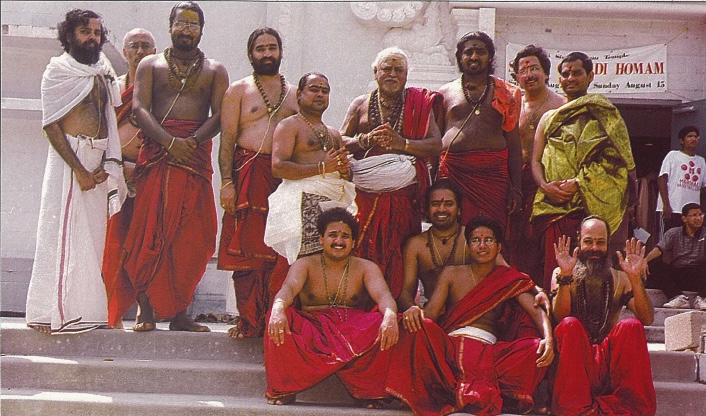The Washington Post, one of America’s most prestigious newspapers, was unhesitating in giving credit where credit was due. In a full-page article August 21, they reported, “The heavens opened three times during a 10-day prayer marathon for rain at Sri Siva Vishnu Temple in Lanham, Maryland, twice in brief but torrential downpours.” Sure, many religious communities in the drought-affected area were praying for rain, but the Hindus were getting the credit for the scale of their ceremonies. In the Satha Chandi Homa, as this special ceremony is called, 100 fire offerings are made to Chandi, one of several names for the Goddess, Devi. It requires at least ten specially trained priests who, according to temple president K.G. Venkatraman, chant for ten days the 700 verses of the ancient Sanskrit text Devi Mahatmyam. At the same time, the priests burn offerings to the Goddess, who receives them through the sacred fire.
The ceremony, the Post reporter wrote, usually is performed in times of great distress, such as famine, drought or violence. According to Venkatraman, its universal appeal for the supreme Goddess’ guidance and blessing led the temple to organize it months ago–long before the onset of the drought.
On the final day, pots of holy water were placed on the altar behind the fire. At the end of the day, the priests and many of the 1,000 congregants carried the pots on top of their heads to the sanctum, where priests ceremonially bathed the temple Deities. Shanmugam Sivachariar, 24, flew from Chennai to assist his father, 75-year-old Dr. T.S. Sambamurthy Sivachariar. Shanmugam told the Post that the spiritual energy in the sacred fire was transferred to the water in the pots, much as water conducts electricity, and the water, in turn, was poured over the images that the temple’s worshipers revere every day. In that way, the Satha Chandi Homa’s power will stay with them. In September, with the above very potent human assistance, hurricane Floyd put a resounding end to the area’s drought.
Ritual rainmaking is a traditional task for Hindu priests, and is found in other cultures as well. The American Hopi Indians do not irrigate their corn crops but rely upon rain dances to water the plants when needed. Modern people scoff at such methods, but the Hopis have survived quite well for thousands of years, trusting that Great Spirit would loosen the clouds for their crops.


